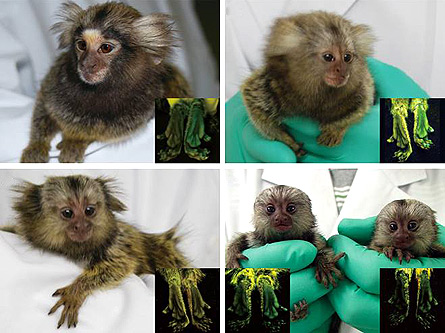- More than 2 years ago
Four little marmosets glowing green could be heralds of a new species for modeling human diseases.

Japanese scientists engineered the marmosets to make green fluorescent protein in all the cells of their bodies, including eggs and sperm. The marmosets are the first transgenic primates — animals that carry a foreign gene. Some of the animals were able to pass the foreign gene to offspring, the researchers report in the May 28 Nature.
“It’s a great achievement,” says Shoukhrat Mitalipov, a developmental biologist at the Oregon National Primate Research Center in Beaverton. Other scientists have introduced foreign genes in other primate species, but the genes were found in only some tissues of the body and in some cases did not make protein, he says.
The new work marks the first time scientists have successfully introduced a foreign gene into all the cells of a primate, and the first time the gene has produced its protein in all the body tissues in a primate. More importantly, the marmosets are also the first primates to transmit the gene to a next generation of animals.
Being able to breed transgenic primates means having to do expensive and difficult genetic engineering only once, then using conventional breeding to make large numbers of transgenic animals.
Transgenic marmosets can be used to study diseases and disorders that affect higher brain structures, Mitalipov says. Specifically, marmosets can model human neurodegenerative diseases, especially those that are dominantly inherited — that is, diseases caused by mutation in a single copy of the gene — says coauthor Hideyuki Okano of Keio University School of Medicine in Tokyo. He plans to use the transgenic marmosets to study Parkinson’s disease and amyotrophic lateral sclerosis, also known as ALS or Lou Gehrig’s disease.
Mice are currently used as models for many human diseases, but are not ideal for studying brain disorders. “The mouse doesn’t give the answers to all the questions we need answered,” Mitalipov says. “There are lots of diseases that can only be modeled in primates.”
Erika Sasaki of the Central Institute for Experimental Animals in Kanagawa, Japan, and her colleagues injected a virus, called lentivirus, into marmoset embryos. The virus carried the gene encoding an enhanced version of green fluorescent protein or GFP, which the virus inserts into the marmosets’ genome. The protein glows green under UV light, so scientists could tell which embryos had GFP inserted.
Sasaki and her colleagues implanted 80 embryos carrying the GFP gene into 50 marmoset surrogate mothers. Only seven animals became pregnant. Three of the surrogate mothers miscarried, but four of the mothers gave birth to healthy infants — three had single babies and one gave birth to twins. Four of the baby marmosets carry the GFP gene and make the glowing green protein in at most of the tissues the scientists tested, including blood, hair and skin. The remaining marmoset doesn’t make GFP in its body, but did carry the gene in its placenta.
A male transgenic marmoset named Kou passed the GFP gene on to two offspring. One of the female transgenic marmosets also had two transgenic babies, Sasaki says.






